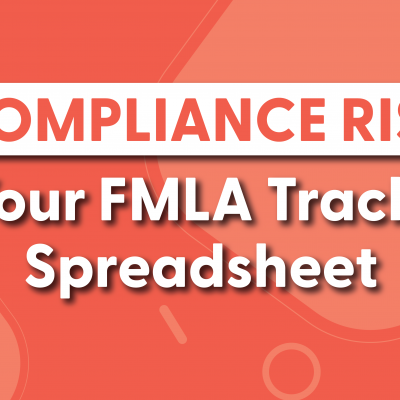Legend has it that if you say, “I have to track FMLA using a spreadsheet,” three times in a mirror your CEO’s burner account gets revealed showing they’ve been secretly campaigning to convince people candy corn is a viable candy option.
Both spreadsheet tracking and candy corn backing are nightmare scenarios that no one in HR wants to have to manage, but the horrors of tracking FMLA using a spreadsheet go beyond administrative nuisances, there are real compliance risks you should be aware of as well.
Understanding these risks can help you identify where you should be auditing your internal processes so you can prevent compliance concerns and reduce the chances your organization will face an FMLA audit itself. Further, it might shed light on the importance of using a modern tech solution to track and manage FMLA for you…yes, that’s an (attractive) option.
1. The Importance of FMLA Data Accuracy and Integrity
One of the significant compliance risks associated with using a spreadsheet to track FMLA leave is the potential for data accuracy and integrity issues. Spreadsheets, while versatile in their own right, are susceptible to human errors in data entry and manipulation. These errors can have severe consequences when it comes to FMLA tracking, as precise recordkeeping is crucial to ensuring compliance.
Precise calculations are the name of the game, and whether it’s the ongoing tracking of both the amount of leave taken and the amount of leave remaining, or maintaining accurate records of employee eligibility, FMLA tracking demands precision. Of course, we’re only human and mistakes happen. With FMLA, however, incorrectly inputting start and end dates, failing to account for overlapping leave periods, or making errors in the hours worked can result in employees receiving more or less FMLA leave than they are entitled to, leading to compliance violations and potential legal repercussions.
Data integrity shouldn’t be overlooked either. Using spreadsheets to track FMLA can lead to having multiple versions of the same important document, which can lead to inconsistencies and uncertainties around what your source of truth actually is. Similarly, housing spreadsheets on a personal hard drive or private folder can cause access issues that may impede the timely need for vital information.
2. Using Spreadsheets For FMLA Recordkeeping
The second critical compliance risk associated with using spreadsheets to track FMLA is the potential for inadequate recordkeeping. Under the FMLA, it’s important to maintain a record of employee requests, certifications, notices, and all correspondence related to leave. Spreadsheets may fall short of providing a structured and organized way to manage and retrieve this wealth of information, which can lead to serious compliance challenges.
Maintaining complete and organized records is essential for demonstrating FMLA compliance during audits or investigations. When records are scattered across multiple spreadsheets or not consistently updated, it becomes challenging to provide evidence of adherence to FMLA requirements. Missing or disorganized records can result in costly compliance violations and legal consequences.
Additionally, FMLA records often need to be retained for an extended period, often for three years or more. Spreadsheets may not have built-in features to ensure data retention compliance, increasing the risk of accidental data deletion or loss.
3. Complex FMLA Leave Entitlement Calculations With Spreadsheets
Just like trying to convince the hypothetical CEO that candy corn isn’t actually edible, managing FMLA leave entitlement is not always straightforward; it can involve intermittent leave, reduced-schedule leave, and eligibility determinations that may change over time. On top of that, it can be complicated to determine when an employee regains FMLA entitlement as well. Spreadsheets simply fall short when trying to handle these complexities accurately and efficiently, and they can potentially put your organization at risk of non-compliance.
Intermittent leave, for example, requires meticulous tracking of sporadic leave days or hours, making manual calculations in spreadsheets error-prone and time-consuming. Similarly, accurately determining reduced-schedule leave entitlement involves detailed calculations that may exceed the capabilities of a standard spreadsheet.
Errors in FMLA leave calculations can result in employees receiving more or less leave than they are entitled to under the law. Overestimating or underestimating leave entitlement can lead to compliance violations, grievances, and legal repercussions.
4. Staying Compliant with FMLA Notification and Communication Requirements
Another fun fact about FMLA is that it mandates specific procedures for both employers and employees to ensure compliance with the law (isn’t that fun?). These procedures include notifying employees of their eligibility, rights, and responsibilities, and providing timely information about leave approvals or denials.
Managing these aspects efficiently and accurately can be challenging within the confines of a spreadsheet. For example, FMLA typically requires you to provide notices regarding an employee’s FMLA eligibility and rights and responsibilities within five business days of the initial request for leave. If you’re using a spreadsheet you’re likely manually tracking and updating these deadlines today.
Failing to meet these notification deadlines can result in, you guessed it, compliance violations.
Also, in order to demonstrate compliance with FMLA, employers should keep proper documentation of communications with employees. This includes records of communications you have with your employees about leave requests, approvals, denials, and any follow-up correspondence. Spreadsheets often lack structured features to centralize and organize these communications, increasing the risk of omissions or misplaced records.
5. FMLA Spreadsheets Have Limited Audit Trail Capabilities
In the event of an employee lawsuit of a DOL audit, you’ll want a thorough audit trail to demonstrate adherence to legal requirements.If audited, you may need to provide data on FMLA usage, employee eligibility, and other relevant information (more info here) to regulatory authorities. Not only are there accuracy concerns with using spreadsheets to track FMLA, they also likely lack the robust reporting capabilities necessary to generate accurate and detailed reports efficiently. As a result, you may struggle to compile the necessary information in a timely and error-free manner.
The word “audit” might send a shiver down your spine, but maintaining an audit trail is crucial for demonstrating FMLA compliance during audits or legal proceedings. An audit trail ensures that all actions related to FMLA, such as leave requests, approvals, denials, and communication, are well-documented and can be easily traced. Your spreadsheets simply just might not provide what’s required to meet these compliance needs.
Alternatives to FMLA Tracking Spreadsheets
Now that we’ve outlined the risks associated with using FMLA tracking spreadsheets, what’s the good news? Comprehensive leave management solutions are out there, like Tilt (shameless plug alert), that specialize in managing all aspects of a leave, no matter the leave type, and include all your FMLA tracking needs.
With advanced reporting capabilities, you can generate accurate, up-to-date, and detailed reports that support compliance efforts all while maintaining a secure and structured audit trail. This means you can ditch the nightmarish spreadsheets and have your FMLA tracked automatically, making it easier to provide evidence of compliance during audits or investigations, thereby reducing the risk of costly compliance violations.
About Tilt
Tilt is leading the charge in all things leave of absence management through easy-to-use tech and human touch. Since 2017, our proprietary platform and Empathy Warriors have been helping customers make leave not suck by eliminating administrative burdens, keeping companies compliant, and providing a truly positive and supportive leave of absence experience for their people.







